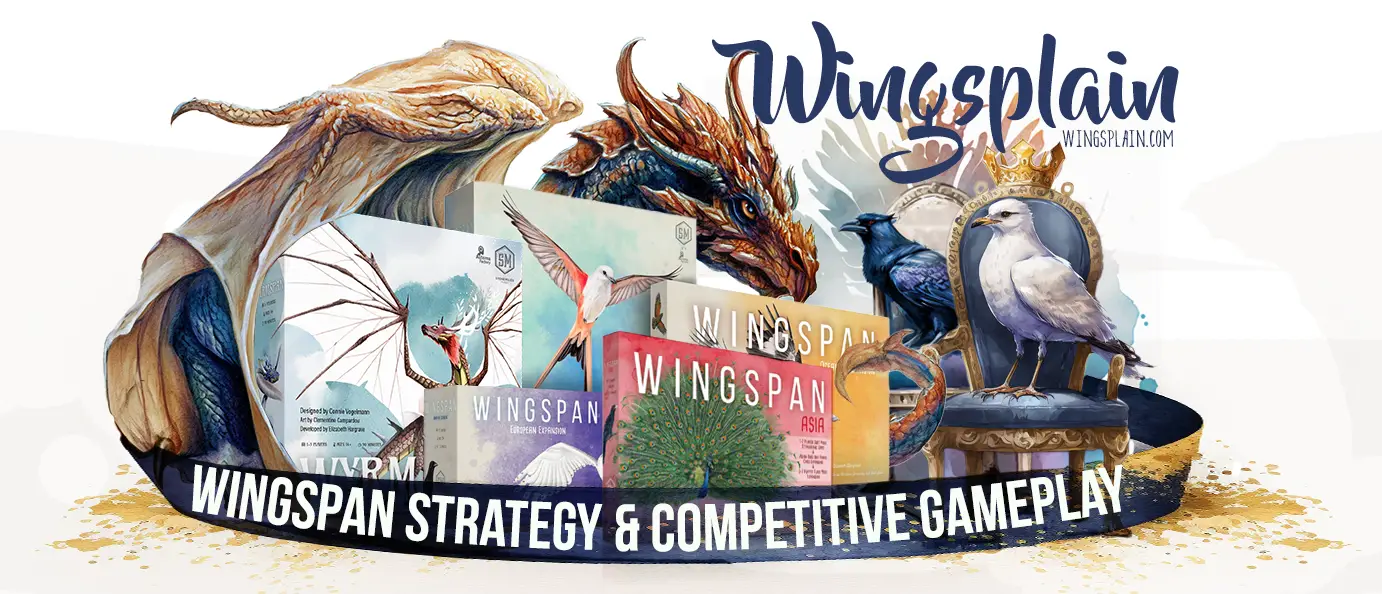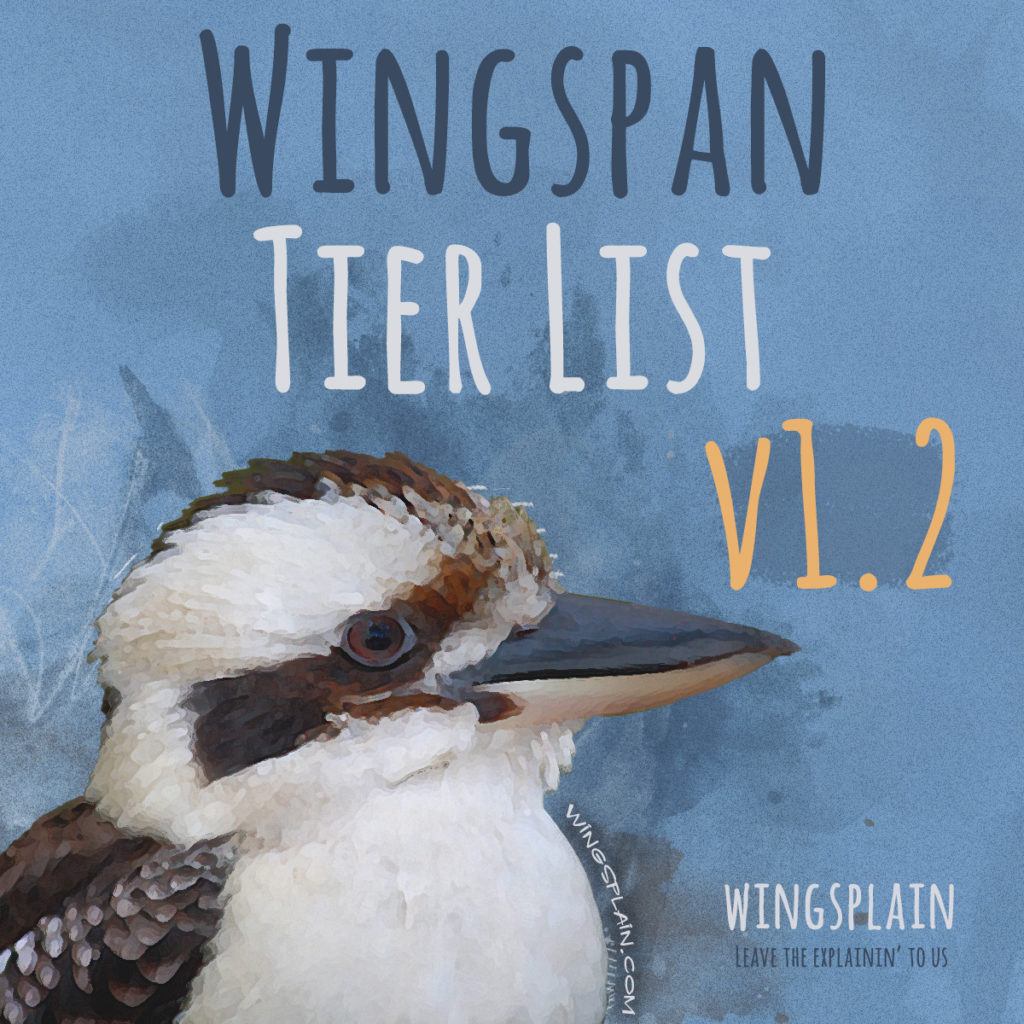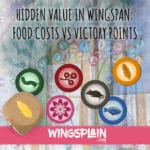In this latest version of the Wingspan Bird Card Tier List, many birds get moved down to lower tiers. Something that can be difficult to determine is, “What does average actually look like in Wingspan?”
Unfortunately, we don’t have the means to really weed out what “average” means in Wingspan. We have to guess at it with a “we know it when we see it” approach over hundreds of plays. It doesn’t help that when we are playing our games, we tend to avoid what we perceive to be “average” and focus on what we perceive to be “above average”. This means that “average” gets tested less than “above average”. As Wingspan ages, we should develop a stronger sense of how cards rank in the middle of the pack instead of just at the extremes (God Tier vs Bottom Tier).
Version 1.2 Changes
- 6 points for 2 food is now currently valued no lower than T4 (down from T3). Strangely enough, 6 point/2 food birds generally have low nest capacity and bad powers.
- Removed T2 ceiling on birds that give Nectar/Wild Food/Bird Feeder Dice to all players.
Cockatiel
T2 to T3
It’s easy to get excited over three habitats, 2 points, and 5 egg capacity for 1 food but its power can be difficult to activate outside the forest without focused support. It’s a beefier Budgerigar.
Painted Whitestart
T1 to T2
Not game bending. Despite doubling your food production by turn 2, being restricted to forest limits its impact. Forest based engines tend to be less impactful. With other, better food gaining birds moving up the list, this one gets pushed down.
Blue Gray Gnatcatcher
T1 to T2
Not game bending. Despite doubling your food production by turn 2, being restricted to forest limits its impact. Forest based engines tend to be less impactful. With other, better food gaining birds moving up the list, this one gets pushed down.
White Throated Dipper
T3 to T4
Fairly vanilla qualities. Restricted to Wetlands.
Coal Tit
T1 to T3
This is part of a Forest engine so you should be good on food from the start. How often does this power make a big impact? It can hold 6 eggs but is otherwise unimpressive. This power is strictly superior to other cache from supply birds.
Eurasian Nuthatch
T1 to T3
This is part of a Forest engine so you should be good on food from the start. How often does this power make a big impact? Its general qualities are unimpressive. This power is strictly superior to other cache from supply birds.
Juniper Titmouse
T3 to T4
Forest engines and caching engines tend to be a bit weaker than other strategies. This card’s core qualities are mediocre. With Coal Tit and Eurasian Nuthatch dropping to T3, this card gets pushed to T4 since it’s power is strictly inferior to those birds.
Carolina Chickadee
T3 to T4
Forest engines and caching engines tend to be a bit weaker than other strategies. This card’s other qualities are mediocre. With Coal Tit and Eurasian Nuthatch dropping to T3, this card gets pushed to T4 since its power is strictly inferior to those birds.
Mountain Chickadee
T3 to T4
Forest engines and caching engines tend to be a bit weaker than other strategies. This card’s other qualities are mediocre. With Coal Tit and Eurasian Nuthatch dropping to T3, this card gets pushed to T4 since its power is strictly inferior to those birds.
White Breasted Nuthatch
T3 to T4
Forest engines and caching engines tend to be a bit weaker than other strategies. This card’s other qualities are mediocre. With Coal Tit and Eurasian Nuthatch dropping to T3, this card gets pushed to T4 since it’s power is strictly inferior to those birds.
Lazuli Bunting
T2 to T3
Requires specific nest type to get the 2nd egg. Gives 1 egg to all opponents that have a specific nest type. Its other qualities aren’t impressive.
Western Meadowlark
T2 to T3
Requires specific nest type to get the 2nd egg. Gives 1 egg to all opponents that have a specific nest type. Its other qualities aren’t impressive.
Common Cuckoo
T2 to T4
Pink Powered egg layers sometimes struggle to make an impact. This version is better than most, but its general qualities are not impressive.
Pheasant Coucal
T3 to T4
Pink Powered egg layers sometimes struggle to make an impact. This version is better than most, but its general qualities are not impressive.
Eastern Rosella
T2 to T4
Two food (1 Nectar + 1 Wheat) from the grasslands can be great but everyone gets that nectar. Otherwise, it’s just an expensive bird with unimpressive general qualities.
Goldcrest
T2 to T3
A cheap egg bank. Holds six eggs for the cost of one food. Its power can be harder to micromanage but can be worthwhile if you have the right resources and the right birds, generating extra actions.
Regent Bowerbird
T2 to T4
Gaining worms in the Grasslands is nice but it helps one opponent, and its general qualities are unimpressive. With other, better food gaining birds moving down the list, this bird is pushed lower as well.
Anhinga
T3 to T4
6 points for 2 food is now currently valued no lower than T4. 6 point/2 food birds generally have low nest capacity and bad powers, strangely enough.
Black Skimmer
T3 to T4
6 points for 2 food is now currently valued no lower than T4. 6 point/2 food birds generally have low nest capacity and bad powers, strangely enough.
Common Loon
T3 to T4
6 points for 2 food is now currently valued no lower than T4. 6 point/2 food birds generally have low nest capacity and bad powers, strangely enough.
Kelp Gull
T3 to T4
6 points for 2 food is now currently valued no lower than T4. 6 point/2 food birds generally have low nest capacity and bad powers, strangely enough.
Major Mitchell’s Cockatoo
T3 to T4
6 points for 2 food is now currently valued no lower than T4. 6 point/2 food birds generally have low nest capacity and bad powers, strangely enough.
Red Crossbill
T3 to T4
6 points for 2 food is now currently valued no lower than T4. 6 point/2 food birds generally have low nest capacity and bad powers, strangely enough.
Elenora’s Falcon
T3 to T4
6 points for 2 food is now currently valued no lower than T4. 6 point/2 food birds generally have low nest capacity and bad powers, strangely enough.
White Stork
T3 to T2
Its White Throated Dipper but better. 8 points, 33% wild food cost, and reliable card draw from the Grasslands.
Anna’s Hummingbird
T2 to T1
100% wild food cost (1 food). Despite giving one birdfeeder die to all players, this bird can make the impossible possible by providing you with any food in the Wetlands and Grasslands. You can manipulate the birdfeeder by forcing your opponents to choose food first, putting you closer to a potential reroll. Hopefully, you use that food more effectively than your opponents.
Ruby Throated Hummingbird
T2 to T1
100% wild food cost (1 food). Despite giving one birdfeeder die to all players, this bird can make the impossible possible by providing you with any food in the Wetlands and Grasslands. You can manipulate the birdfeeder by forcing your opponents to choose food first, putting you closer to a potential reroll. Hopefully, you use that food more effectively than your opponents.
Bluethroat
T2 to T1
It’s expensive but can provide wild food from where it matters most, Wetlands and Grasslands. This is one of two birds in the game that are worth 7+ points and can hold 5+ eggs. Hopefully, you use that food more effectively than your opponents.
Common Nightingale
T2 to T1
This basically fits into the Hummingbird archetype. Cheap and flexible food cost. Any habitat. Wild food from Wetlands and Grasslands. This is one of two birds in the game that only costs one food and is worth 3+ points while also holding 4+ eggs. Hopefully, you can use that food more effectively than your opponents.



